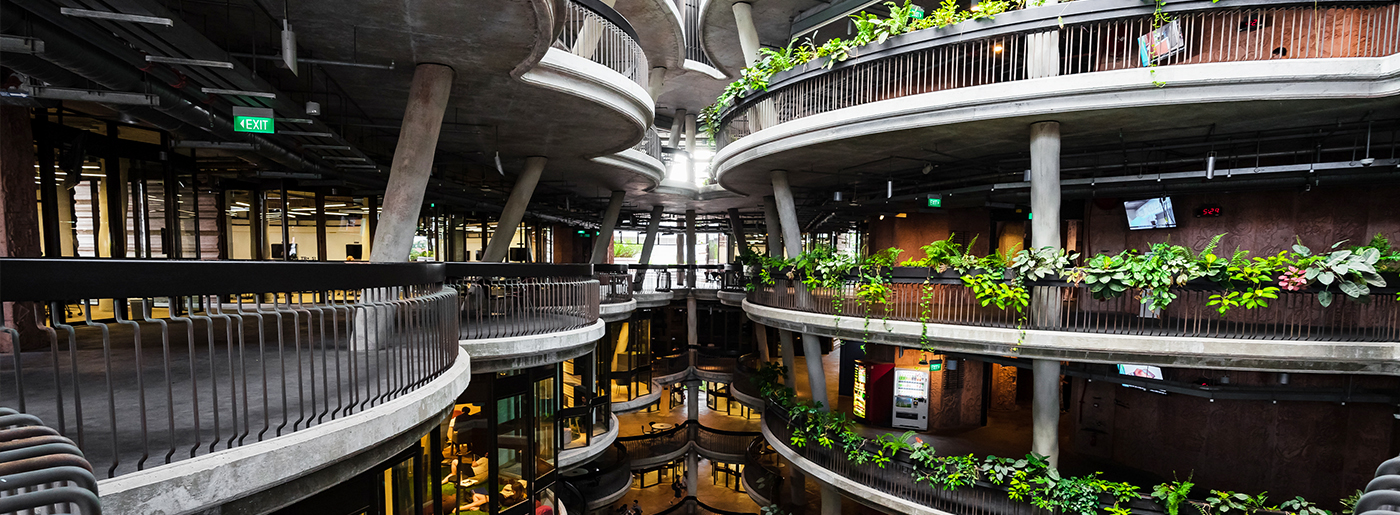“Singapore is the latest city to unveil a mass timber building, as the case for wood in construction becomes more and more compelling”
Since its inception, Singapore has promoted itself as a “garden city,” a term first used by the country’s first prime minister and founding father, Lee Kuan Yew, in the 1960s. Since then, the island has implemented massive tree-planting initiatives and adopted “biophilic” design principles, such as incorporating plants into the structure of buildings.
Singapore’s newest tribute to the outdoors is a six-story skyscraper on a college campus. There are lifts that descend into beds of tropical plants in this gently curved building that houses the business school of Nanyang Technological University (NTU). Wood was used for the railings, seats, door frames, dividers, and even the next bus stop.
The supporting columns and beams were also made of wood. The majority of the structure is constructed from mass timber, an innovative type of engineered wood that is stacked and held together using adhesives. The massive structure covers an area of 43,500 square metres (468,000 square feet), making it the biggest timber building in Asia.
The project, which opened in May and cost 125 million Singapore dollars (about £75 million), was named Gaia after the ancient Greek goddess of the Earth. The lack of covering or paint on the exposed timber frame is a design choice that honours nature and gives visitors the impression that they are strolling through a forest.
Toyo Ito, the renowned Japanese architect who conceived the project, says that this was the intention all along. Shortly after the building’s dedication, he told the press: “I always try to envision a connection with — and a feeling of — nature, such as trees and water, in my designs. The fact you mentioned that it feels like entering a forest shows that my vision came through.”
Gaia was created by Ito and the Singaporean company RSP, who shared the 2013 Pritzker Prize (often referred to as the “Nobel” of architecture). There are 190 seats in the theatre, 12 lecture halls, faculty offices, and outdoor study terraces.
Austrian, Swedish, and Finnish spruce wood was used to construct the building, with concrete used for the bathrooms, ground-floor slabs and outside stairs (in part owing to local requirements). The timber was initially processed in Europe into panels and robust beams before being delivered to Singapore.
The construction of mass timber structures has seen a dramatic uptick in recent years all across the globe. High-rise buildings (or “plyscrapers”) are now legal in several nations; the Ascent in Milwaukee, Wisconsin is the highest mass timber building at 25 stories, or 284 feet.
Many Western and North American cities have been quicker to adopt the practise than their Asian counterparts. At the time Gaia was authorised, Singapore’s building standards limited the height of timber construction to 24 metres (79 feet), however this limit has since been removed. Ito, 81, says that people’s perspectives on things are “changing rapidly” in Asia, and that “Singapore is especially quick to make these things a reality.”
There are many good reasons behind the world’s increasing attraction to timber buildings. The dust and noise on building sites may be reduced by as much as 35% when mass wood is used, according to the Singapore Building and Construction Authority (BCA). Wooden structures, it is said, may be safer than steel-framed ones in the event of a fire, and less likely to collapse catastrophically.
In addition, buildings use up around 40% of global energy, both during construction and operation. In contrast to the energy-intensive manufacture of concrete and steel, which contributes significantly to the environmental footprint of structures, trees absorb carbon dioxide throughout the course of their lives.
This embedded carbon is stored, or “locked in,” rather than being released back into the atmosphere if the tree is processed into mass wood. Carbon dioxide may be stored in wood at a rate of roughly 1 tonne per cubic metre, according to studies.
Finally, timber is a natural insulator, meaning that it keeps less heat inside in hot regions like Singapore (or prevents heat loss in cooler climes) than concrete does. Gaia’s architects claim that, when in use, the building emits 2,500 metric tonnes less carbon dioxide than concrete or steel equivalents yearly, which is the same as if more than 550 cars were removed from the road for an entire year.
The case for greater use of wood in construction is becoming increasingly obvious. If you would like guidance on which variety of timber would be perfect for your next project – even if it isn’t Asia’s tallest timber building – please contact Quercus on 0845 50 50 311.

